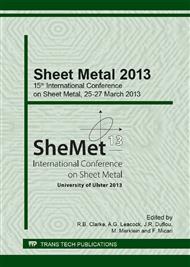p.484
p.492
p.503
p.511
p.521
p.529
p.537
p.547
p.557
Characterizing Influence Parameters in Pulsed Phase Thermography for Defect Detection in Sheet Metal Parts
Abstract:
Pulsed phase thermography (PPT) is a common infrared technique for quantitative nondestructive testing and evaluation (NDT&E). PPT was initially applied in the aeronautical and aerospace engineering to the detection and quantification of defects in materials with either high or low thermal conductivity, such as aluminium and composite materials. This paper presents for the first time the application of PPT-technique for defect inspection in sheet metal parts, attempting to provide a solution for an alternative quality control rather than the traditional optical survey in the press shop. The inspected defects in this paper were produced in deep drawing cups, to effectively creating various crack lengths and depths respectively in both steel and aluminium alloys. The approach of the characterizing influence parameters is primarily based on the particular parameters of the PPT-technique. These parameters were firstly classified into various categories, and a DoE model was subsequently designed to define the required experiments for a process window analysis. According to the defined process window, more accurate conclusions of defect detecting effects were achieved. Studies in the paper present the fundamental perceptions for defect inspecting in the sheet metal parts by using PPT-technique in the press shop.
Info:
Periodical:
Pages:
521-528
Citation:
Online since:
April 2013
Authors:
Price:
Сopyright:
© 2013 Trans Tech Publications Ltd. All Rights Reserved
Share:
Citation:


